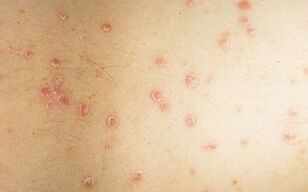According to official figures, about 3% of people around the world suffer from psoriasis. But it should be assumed that the actual number of patients with this type of dermatosis is much higher. Basically, the first signs of such a disease appear at the age of 10-25 years, although cases of psoriasis have been recorded in both infants and the elderly. It’s still not certain why it develops, but doctors have information about what the initial stage of psoriasis looks like. Therefore, timely referral of specialists succeeds in halting the progression of the disease at the earliest stages.
Early Stage Symptoms
Initially, small round papules begin to appear on the patient's skin, the size of which usually does not exceed the diameter of the needle head. These formations have a smooth, glossy surface and clean contours, but literally begin to peel off in a few days. The resulting scales are silver white and can be easily removed from the surface of the papule. Over time, the number and size of the elements of the rash increase and the disease progresses to a progressive stage.
Papules are usually reddish or pink, although they turn bluish in some situations. This can be observed with the formation of the primary elements of the rash on the legs. Depending on the type of disease, the initial stage of psoriasis occurs on the elbows (extensor surfaces), knees, body, limbs, or scalp.
If you remove all the scales from the pimple, you will find an absolutely smooth glossy surface underneath - the final foil. But with further scraping, it is quickly damaged and the smallest drop of blood begins to appear.
So psoriasis is characterized by three specific phenomena:

- stearin stain- increased exfoliation when removing scales;
- psoriasis film- exfoliation of the thinnest layer of skin;
- blood dew- the appearance of exact drops of blood after scraping.
But it’s much easier to see what the initial stage of psoriasis looks like in a photo.
Despite all the advances in medicine, no cure has been developed today that would completely cure psoriasis. This disease is characterized by a wave-like course, so it occurs not only in the early stages of its development, those who first encountered a similar disease, but also those who have lived with it for years.
I would like to emphasize that there is no cure for psoriasis. With the help of modern medicines, physiotherapy procedures and other methods of therapy, you can "steer" the disease into a state of stable remission and even forget about it for several years. But this does not mean that in the case of an unfavorable combination of conditions, the patient again does not notice the characteristic rashes that show the initial stage of psoriasis on the hands and other parts of the body.
How do I know if my psoriasis is progressing?
The transition of psoriasis to the second or progressive stage is evidenced by the growth and fusion of previously unique papules and the addition of hitherto missing pruritus. In addition, the nature of peeling also changes. Now it can only be observed in the middle of the formations and their edges remain free of scales. This is a clear indication of the increase in batteries.
You can use a type of test to confirm the transition of psoriasis to the second stage. Its essence is minor damage to the skin of the affected area. If, after about a week, a psoriatic element of the same shape as the injury forms in the same place, this clearly indicates the progression of the disease. Such a test is described in the literature as a symptom of Kebner. Moreover, this can be observed even by banal combing of the affected skin.
In some cases, patients suffer from exudative psoriasis. It is characterized by the release of a special fluid. The scales are impregnated with it, resulting in a dense crust. If one of the bark is removed or damaged, the leaking skin surface is exposed.























